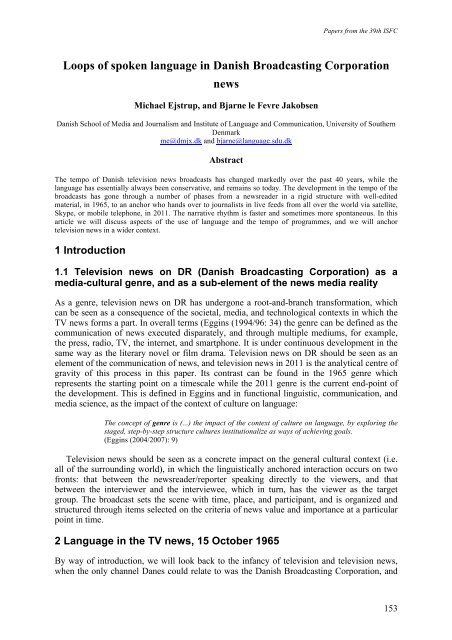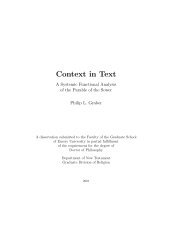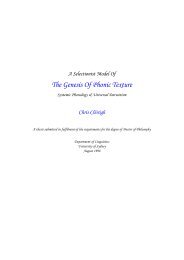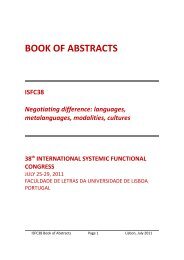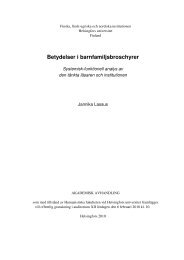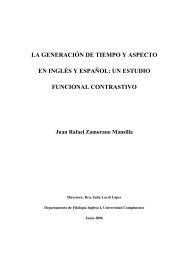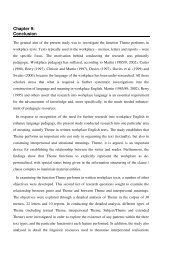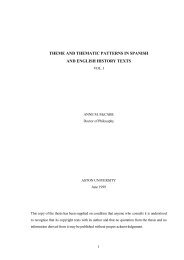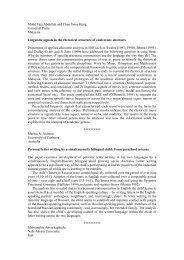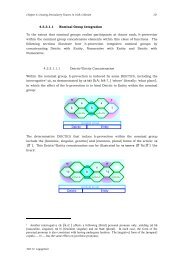the ISFC39 Proceedings - International Systemic-Functional ...
the ISFC39 Proceedings - International Systemic-Functional ...
the ISFC39 Proceedings - International Systemic-Functional ...
You also want an ePaper? Increase the reach of your titles
YUMPU automatically turns print PDFs into web optimized ePapers that Google loves.
Papers from <strong>the</strong> 39th ISFCLoops of spoken language in Danish Broadcasting CorporationnewsMichael Ejstrup, and Bjarne le Fevre JakobsenDanish School of Media and Journalism and Institute of Language and Communication, University of Sou<strong>the</strong>rnDenmarkme@dmjx.dk and bjarne@language.sdu.dkAbstractThe tempo of Danish television news broadcasts has changed markedly over <strong>the</strong> past 40 years, while <strong>the</strong>language has essentially always been conservative, and remains so today. The development in <strong>the</strong> tempo of <strong>the</strong>broadcasts has gone through a number of phases from a newsreader in a rigid structure with well-editedmaterial, in 1965, to an anchor who hands over to journalists in live feeds from all over <strong>the</strong> world via satellite,Skype, or mobile telephone, in 2011. The narrative rhythm is faster and sometimes more spontaneous. In thisarticle we will discuss aspects of <strong>the</strong> use of language and <strong>the</strong> tempo of programmes, and we will anchortelevision news in a wider context.1 Introduction1.1 Television news on DR (Danish Broadcasting Corporation) as amedia-cultural genre, and as a sub-element of <strong>the</strong> news media realityAs a genre, television news on DR has undergone a root-and-branch transformation, whichcan be seen as a consequence of <strong>the</strong> societal, media, and technological contexts in which <strong>the</strong>TV news forms a part. In overall terms (Eggins (1994/96: 34) <strong>the</strong> genre can be defined as <strong>the</strong>communication of news executed disparately, and through multiple mediums, for example,<strong>the</strong> press, radio, TV, <strong>the</strong> internet, and smartphone. It is under continuous development in <strong>the</strong>same way as <strong>the</strong> literary novel or film drama. Television news on DR should be seen as anelement of <strong>the</strong> communication of news, and television news in 2011 is <strong>the</strong> analytical centre ofgravity of this process in this paper. Its contrast can be found in <strong>the</strong> 1965 genre whichrepresents <strong>the</strong> starting point on a timescale while <strong>the</strong> 2011 genre is <strong>the</strong> current end-point of<strong>the</strong> development. This is defined in Eggins and in functional linguistic, communication, andmedia science, as <strong>the</strong> impact of <strong>the</strong> context of culture on language:The concept of genre is (...) <strong>the</strong> impact of <strong>the</strong> context of culture on language, by exploring <strong>the</strong>staged, step-by-step structure cultures institutionalize as ways of achieving goals.(Eggins (2004/2007): 9)Television news should be seen as a concrete impact on <strong>the</strong> general cultural context (i.e.all of <strong>the</strong> surrounding world), in which <strong>the</strong> linguistically anchored interaction occurs on twofronts: that between <strong>the</strong> newsreader/reporter speaking directly to <strong>the</strong> viewers, and thatbetween <strong>the</strong> interviewer and <strong>the</strong> interviewee, which in turn, has <strong>the</strong> viewer as <strong>the</strong> targetgroup. The broadcast sets <strong>the</strong> scene with time, place, and participant, and is organized andstructured through items selected on <strong>the</strong> criteria of news value and importance at a particularpoint in time.2 Language in <strong>the</strong> TV news, 15 October 1965By way of introduction, we will look back to <strong>the</strong> infancy of television and television news,when <strong>the</strong> only channel Danes could relate to was <strong>the</strong> Danish Broadcasting Corporation, and153


